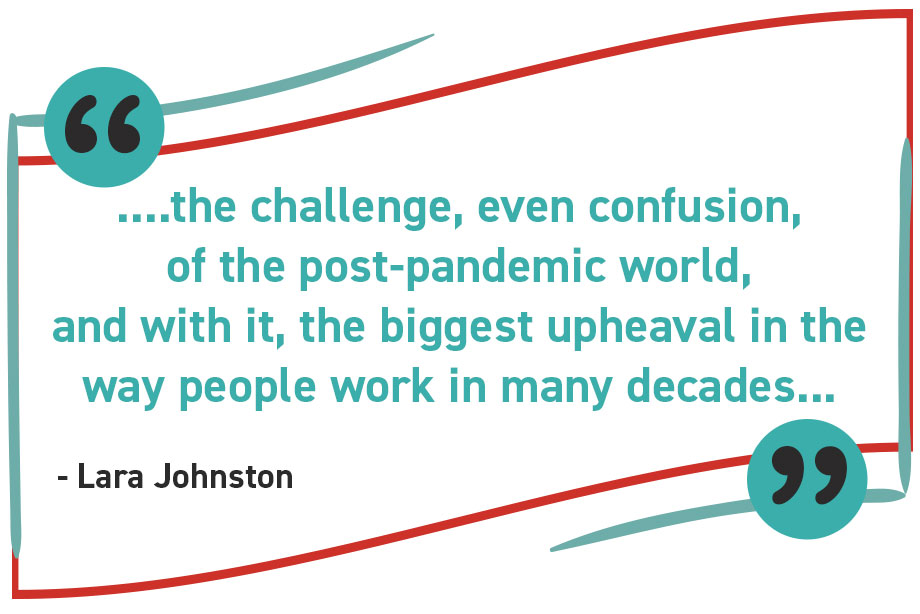Reflections on 2022 Workplace Transitions
by Lara Johnston
As 2022 draws to an end, it’s timely to reflect on the year that was, and offer some observations on the significant changes we have seen in the workplace environment, especially as a result of the transition to hybrid work.
While our client base is broad and diverse, and each client unique, some common themes have emerged. What’s also shared is the challenge, even confusion, of the post-pandemic world, and with it, the biggest upheaval in the way people work in many decades.
Among the biggest challenges for our clients is how to entice employees back to the office. Businesses need to “earn the commute” from their employees to overcome the time, cost, health, risk and frustration of travel.
Therefore, how do we create “places with purpose” to create a worthwhile and engaging experience; to facilitate collaboration, connection or concentration. Also, how do we use the office environment to help attract new recruits?
From Incorp’s point of view, here are some insights we’ve gained during this profound transition period.
Place
How much space do you need, especially if a new lease is being negotiated?
With various flexible and hybrid working models now in place, including trials of the 4-day work week, how do you determine the most effective use of space? It’s a significant challenge, and indeed it’s one that impacts – potentially dramatically – on the bottom line.
Noting the challenge, one clear observation is the importance of employee surveys to determine employees’ preferred approach to work – including where, ideally, they prefer to work; and the particular tasks they like to do at home versus the things they prefer to do in an office environment with members of their team. To facilitate this, employers should also identify appropriate tools to equip them with such information. And they should also note the tendency of employee preferences to change over time. As such, regular employee check-ins are required, as are facilitated discussions between employers and their staff (which can, potentially, help guide outcomes).
Consider the maximum amount of space necessary in order to accommodate the largest number of staff who, realistically, will attend the office at once.
Downsizing is common, however, surprisingly, others are upsizing.
As we work with clients across the country, we’ve noted that many organisations are returning staff to individual personal workspace (in contrast to the pre-pandemic trend of ‘hot-desking’) and, even where flexible work policies are in place, employees are being required to have ‘anchor’ days in the office (often 2 or 3 days a week).
In recognition of what may be permanent changes to the world of work, other organisations are, perhaps unsurprisingly, reducing their footprint office, while others are creating office neighbourhoods, or instigating in-office team days, which sees staff rotating through a workplace over the course of a week.
Another observation is that because of increased construction costs and high vacancy rates, more building owners are providing ‘turn-key’ options for employers, with many well fitted-out office space now available for lease. Others are creating precincts within their buildings, and including community facilities such wellness and social spaces, including cafes/restaurants, outdoor areas, and bonus services such as a concierge service.
With many people wanting to work in offices that are closer to home, and with the normalising of video conferencing technology, city fringe locations for office are being increasingly discussed. However, such locations nevertheless require easy access to transport, which can be a challenge in
certain parts of our capital cities. Proximity to cafes is also important as it enhances the employee experience and thereby helps employers make the case for in-office attendance.
People
Workplace culture suffered significantly with the rapid and wholesale change to working from home. The creation of ‘social spaces’ is therefore a high priority in the allocation of space within an office, recognising the great need to encourage and create a collegial environment for face-to-face interaction.
The formality of many office environments has eased off substantially. Working from home has shifted expectations of the feel of a workspace towards a residential and inviting space (like home) and moving away from corporate environments. Reception areas are slowly disappearing (along with men’s business ties!), and they are being replaced by digital sign-ins and casual waiting spaces (even a café or a bar). Perhaps beaming into each-others lounge rooms has blurred the lines between home and work, and created a more transparent and honest way of communicating.
Also in demand are social spaces for people to gather for a chat, a coffee or a drink, or even a game of pool/table tennis/darts. These areas are about enhancing team connection and collegiality, and we’ve noted that Thursday night drinks are, increasingly, the new Friday.
Investment in well-designed, quality furniture and technology is also helping attract employees back to the office. Examples include excellent, ergonomic solutions, such as sit-to-stand desks and topshelf task chairs – features employees may not have the benefit of at home.
Overall, it has been encouraging to see the weight that organisations are now placing on engaging their employees in a conversation about the direction of and model for work. Investing time in people goes a long way to putting the human element back into the workplace experience. And by providing high-quality and fit-for-purpose facilities within a workplace, it will enable people to achieve their best and become even more valuable for their organisation.




